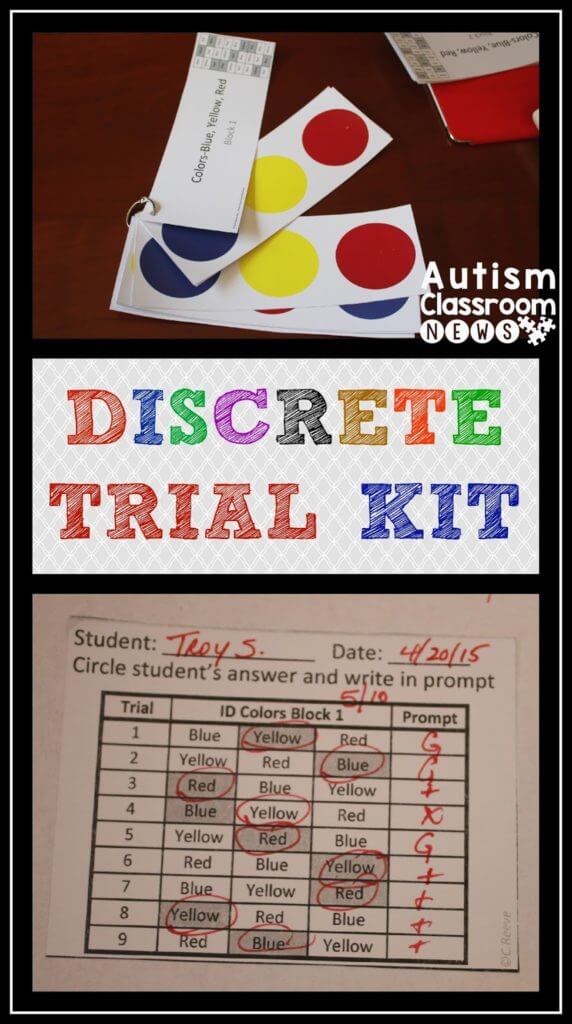 As I was thinking about the next steps, I realized that it didn’t make much sense to create a new kit for matching colors because many of the materials were going to be very similar. So, I decided that I’m going to update the current discrete trial kit to include matching colors and expressive ID of colors. I will raise the price a little but. However, if you have already purchased the kit, or purchase it before I get it updated (which I hope will be in the next couple days), you will get the updated version for FREE.
As I was thinking about the next steps, I realized that it didn’t make much sense to create a new kit for matching colors because many of the materials were going to be very similar. So, I decided that I’m going to update the current discrete trial kit to include matching colors and expressive ID of colors. I will raise the price a little but. However, if you have already purchased the kit, or purchase it before I get it updated (which I hope will be in the next couple days), you will get the updated version for FREE.
So, I wanted to show you a bit more about what is included in the kit and how it works. Check out the pictures and description below.
The kit covers the colors red, yellow, blue, purple, green, orange, black, brown and white. The colors are taught first in arrays of 3, then in arrays of 5 and then in messy arrays of 9. I set up the materials so that you can have the student point to the pictures on the computer screen, on an iPad or print them out. The expressive ID pictures are also set up so they can be done on the iPad, computer or with paper so they are set up to show only one item at a time and you ask, “What color?” All the arrays are set up so you can pick them up in present them in a specific order to avoid any type of placement bias or tells from giving away the answer. This should make it easier to have someone else in your class present trials at times and still get consistency. You will still know what has been presented and in what way.
 Each set of materials has a data sheet that goes with it. I’ve tried to make the data sheets as easy to use as possible. You can cut the data sheets apart into the blocks that match the arrays you want presented. Tape them to a page so that the instructor can mix up blocks of trials of different skills (I’ll talk more in future posts about why this is important). Then they can take data directly on the paper by circling the answer the student gave. Then, if you printed the data sheets on sticker / label paper, simply peel off the back and paste it into the student’s program book. I also included a data sheet for graphing the results to summarize all the data.
Each set of materials has a data sheet that goes with it. I’ve tried to make the data sheets as easy to use as possible. You can cut the data sheets apart into the blocks that match the arrays you want presented. Tape them to a page so that the instructor can mix up blocks of trials of different skills (I’ll talk more in future posts about why this is important). Then they can take data directly on the paper by circling the answer the student gave. Then, if you printed the data sheets on sticker / label paper, simply peel off the back and paste it into the student’s program book. I also included a data sheet for graphing the results to summarize all the data.
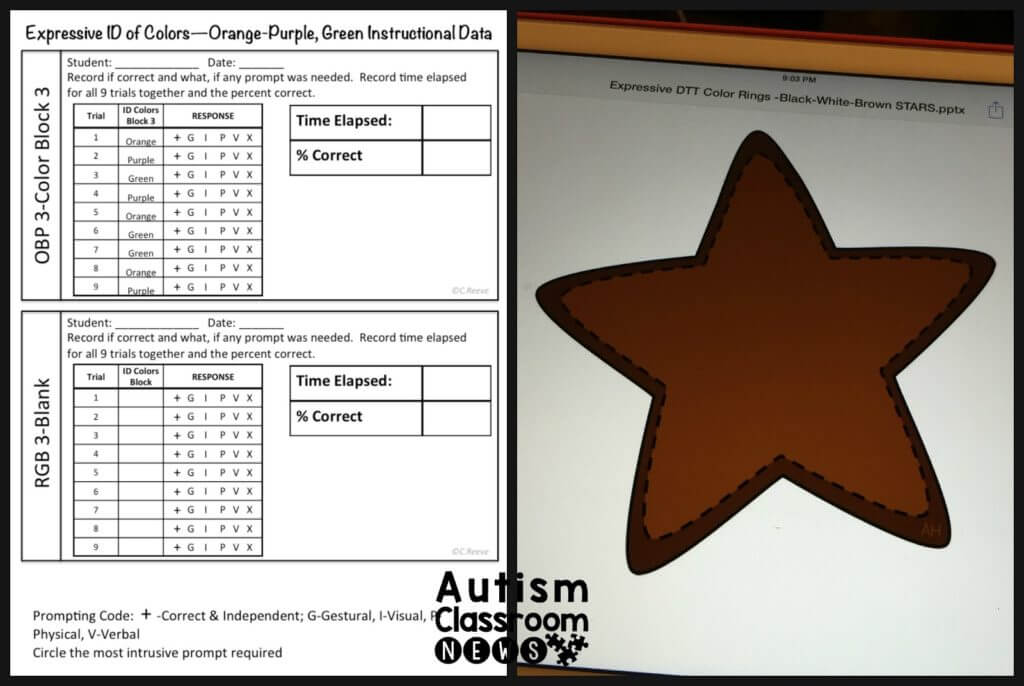 For the expressive ID items, there is one color per card that is shown to the student and you can take data by circling the level of prompting (or independent) on the data sheet. To address fluency, there is also a place to record how long it takes the student to name all 9 colors. It’s easy to move quickly through the set whether you are using it on a screen (turn the page) or using them in a printed form on a ring. Each set of 9 colors is carefully counterbalanced so that each color appears in one part of the set 3 times–you can see how they are set up in the picture below. For the matching, you use a file with 1 color per card to match to the same arrays you use for expressive ID. Within the three blocks of 9 cards, each color appears on time in each of the 9 spaces and no color is presented more than twice in a row (the expressive single cards are a bit different).
For the expressive ID items, there is one color per card that is shown to the student and you can take data by circling the level of prompting (or independent) on the data sheet. To address fluency, there is also a place to record how long it takes the student to name all 9 colors. It’s easy to move quickly through the set whether you are using it on a screen (turn the page) or using them in a printed form on a ring. Each set of 9 colors is carefully counterbalanced so that each color appears in one part of the set 3 times–you can see how they are set up in the picture below. For the matching, you use a file with 1 color per card to match to the same arrays you use for expressive ID. Within the three blocks of 9 cards, each color appears on time in each of the 9 spaces and no color is presented more than twice in a row (the expressive single cards are a bit different).
My hope is that this is a set that will make running discrete trials in the classroom easier because the materials can be ready to go, assure integrity of the implementation if used in the order they are set up, and the data sheets give you information about what the student responded while still being easy to use while teaching.
If you are interested, you can check out the video about the receptive ID part of the product in the video below. You can also check out the previews for the Receptive ID kit on TPT and even download a sampler of receptive ID of blue, yellow, and red for free from my store. I also set them up so you can print all the materials at different sizes and print multiples to a page. For more information about that, check out this video. And remember, if you purchase before I update it, you will get the additional expressive ID and matching materials and data sheets for FREE!

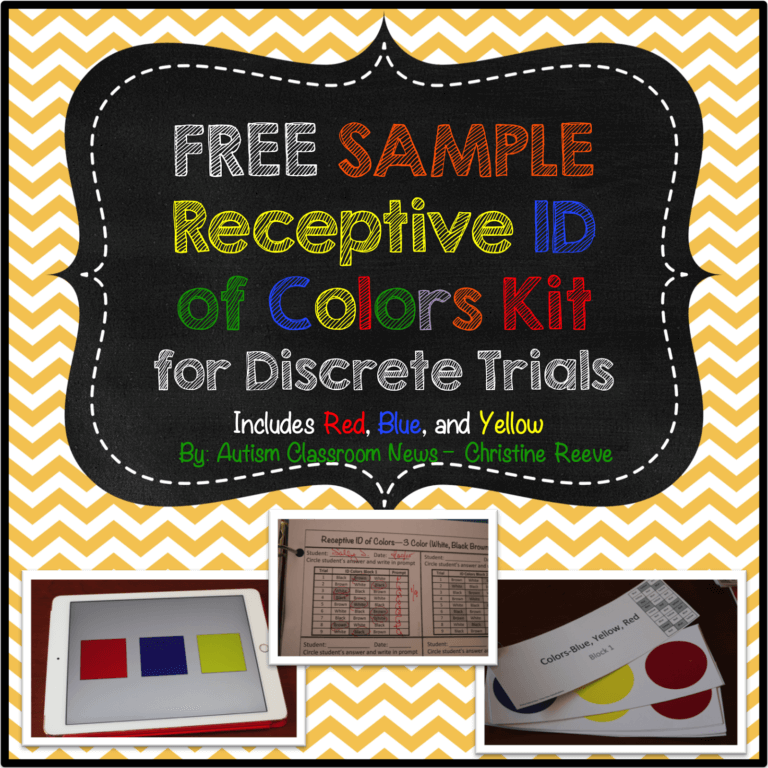
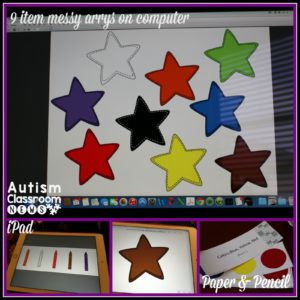


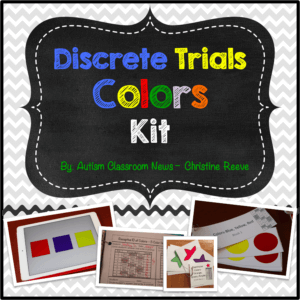
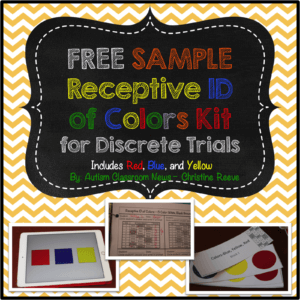


![Summer resources to help survive the end of the year in special education [picture-interactive books with summer themes]](https://autismclassroomresources.com/wp-content/uploads/2018/05/SUMMER-RESOURCES-ROUNDUP-FEATURE-8528-768x768.jpg)

